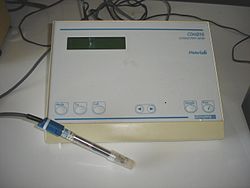- Electrical conductivity meter
-
An electrical conductivity meter (EC meter) measures the electrical conductivity in a solution. Commonly used in hydroponics, aquaculture and freshwater systems to monitor the amount of nutrients, salts or impurities in the water.
Contents
Principle of operation
The common laboratory conductivity meters employ a potentiometric method and four electrodes. Often, the electrodes are cylindrical and arranged concentrically[citation needed]. The electrodes are usually made of platinum metal. An alternating current is applied to the outer pair of the electrodes. The potential between the inner pair is measured[citation needed]. Conductivity could in principle be determined using the distance between the electrodes and their surface area using the Ohm's law but generally, for accuracy, a calibration is employed using electrolytes of well-known conductivity.
Industrial conductivity probes often employ an inductive method, which has the advantage that the fluid does not wet the electrical parts of the sensor. Here, two inductively-coupled coils are used. One is the driving coil producing a magnetic field and it is supplied with accurately-known voltage. The other forms a secondary coil of a transformer. The liquid passing through a channel in the sensor forms one turn in the secondary winding of the transformer. The induced current is the output of the sensor.
Temperature dependence
Main article: Electrical conductivityThe conductivity of a solution is highly temperature dependent, therefore it is important to either use a temperature compensated instrument, or calibrate the instrument at the same temperature as the solution being measured. Unlike metals, the conductivity of common electrolytes typically increases with increasing temperature.
Over a limited temperature range, the way temperature affect conductivity of a solution can be modeled linearly using the following formula:
where
- T is the temperature of the sample,
- Tcal is the calibration temperature,
- σT is the electrical conductivity at the temperature T,
- σTcal is the electrical conductivity at the calibration temperature Tcal,
- α is the temperature compensation slope of the solution.
The temperature compensation slope for most naturally occurring waters is about 2 %/°C, however it can range between 1 to 3 %/°C. The compensation slope for some common water solutions are listed in the table below.
Aqueous solution at 25 °C Concentration (mass percentage) α (%/°C) HCl 10 1.56 KCl 10 1.88 H2SO4 50 1.93 NaCl 10 2.14 HF 1.5 7.20 HNO3 31 31 See also
External links
- IEEE paper telling how a four electrode meter works
- Sales literature telling how a four electrode meter works
- A webpage by Horiba telling about temperature compensation
- A book which includes a discussion of temperature compensation
- Cole–Parmer article on conductivity and conductivity meters
- Milli-Q System High Precision Coaxial Resistivity Cell
- ASTM D1125 - 95(2009) Standard Test Methods for Electrical Conductivity and Resistivity of Water
Categories:- Electrochemistry
- Measuring instruments
Wikimedia Foundation. 2010.


![\sigma_T = {\sigma_{T_{cal}}[1 + \alpha (T - T_{cal})] }](1/5d1c6a77617c0d016baa52d374e8f005.png)